In early April, several hundred scientists converged in the Netherlands for the first-ever meeting of the Society for Interdisciplinary Placebo Studies. The topic drew psychologists, psychiatrists, physiologists, ethicists and neuroscientists, all enthusiastic about focusing a wider lens on a booming area of study: investigation of how beliefs, expectations and motivations can shape health. The well-documented, if often incidental, effects of placebos — drugs with no active ingredients, or other shams concocted to better measure another therapy’s effect — have triggered that boom.
But even before the conference date had been set, something was bothering some prospective attendees, an annoyance that had gnawed at a few of them for years. It was the word placebo itself. And though it seems like a small issue — a word choice, a semantic nuisance — it struck scholars like clinical psychologist John Kelley of Harvard that the name was having an outsize effect on doctors’ ability to harness the power of placebos for good.
For starters, the name defies logic. “‘The placebo effect’ in and of itself is an oxymoron,” Kelley says. “The placebo effect is the effect of something that has no effect. That can’t be true.”
“‘The placebo effect’ in and of itself is an oxymoron.”
JOHN KELLEYEven if it were true, the name comes with baggage. Studies have found that placebos can dampen pain, relieve anxiety and help headaches. Yet despite its growing resumé, placebo effect still carries a strong whiff of woo. That name implies a fake, a sham, an intention to deceive, says neuroscientist Vitaly Napadow of Massachusetts General Hospital and Harvard Medical School. “The word placebo has a really bad connotation that’s holding it back in a way from actually being something we use.”
That bad rap came up again in a musty room tucked away in Leiden during a small gathering the day before the official placebo meeting began. Napadow, Kelley and about two dozen other scholars convened to talk about how placebos might transform clinical practice. But almost immediately, the conversation turned to vocabulary as the scientists debated the advantages and practicalities of a rebranding campaign for the poor, shamefaced placebo.
Their objection goes beyond PR. The real problem, they argue, is that the term placebo effect is incorrect. Sugar pills, pretend surgeries and fake acupuncture needles are supposed to be inert, existing only so that something else (the “real medicine”) can shine. For people studying placebos seriously, that narrow, dismissive way of thinking is limiting. Placebos fails to capture the deeper essence of how beliefs actually can and do transform the body.
But if the old term no longer makes sense, what then to call it?
“Language is a real problem here,” Kelley says. But if the old term no longer makes sense, what then to call it? Alternatives — “meaning response,” “expectancy response,” “non-specific effect,” and “context effect” — come with their own squishiness. Kelley, ticking through the list of proposed substitutions, admits there’s still no lexical savior.
The meeting ended with no new name, only an acknowledgment that the name, and the concept, of placebos remains a substantial roadblock to incorporating them into everyday medical practice.
Still, research marches on. Today’s growing evidence of placebo power is built on more sophisticated explanations of just how beliefs can change the body, as revealed in a bevy of neuroscientific studies. Scientists are figuring out when thoughts and expectations can change outcomes, and when they can’t. More interestingly, these effects aren’t always due to simple learned associations — take a sugar pill, feel better. Instead, the placebo effect appears to hook into a much more active and broad-based neural process, one in which the brain builds its own expectations from a wide range of clues. And that active construction of reality may simply be how our brains work in all situations, making guesses about what will happen next based on past experience and present cues.

Researchers looking at how the brain builds the expectations that fuel the placebo response have recently identified one brain region — the ventromedial prefrontal cortex — as particularly important, serving as a neural hub for transforming beliefs into body responses. This brain network helps place a person in context relative to the outer world, a situational awareness that then leads to predictions about, among other things, whether a treatment, sham or real, might work. Other neural networks are no doubt involved, too, depending on the situation. The search for a better name may signal a field coming of age, helping scientists define the mysterious process by what it is and what it isn’t.
This, not that
One scenario where the term placebo effect fails is in talking about active drugs. Morphine behaves very differently based on whether people know they’re getting it or not. A powerful opiate falters when people don’t know they’ve taken it. That’s not a placebo effect, because there is no placebo. Still, it feels like it should be one, since it’s based on the user’s expectations, Kelley says. “It seems to me that it is exactly the same thing.” Similarly, people can experience negative side effects from a placebo, if that’s what they are expecting. This phenomenon is called the nocebo effect (more problematic vocabulary).
>k_subscribe_ad<>/k_subscribe_ad<Another example comes from studies in psychologist Alia Crum’s lab at Stanford. She and her colleagues gave two groups of people shakes to drink. One group was told the shakes were healthful; the other was told the shakes were an indulgent treat. The shakes were identical, but the people’s bodies responded very differently. The hunger-stimulating hormone ghrelin, produced in the gut, was three times lower in the people who had the “indulgent” shake, as if they knew they should feel sated, Crum and colleagues reported in 2011. In that study, “there’s no doctor, there’s no patient, there’s no placebo,” Kelley says. “Is this the same phenomenon? Not exactly, but to me, it’s very similar.”
“The clinical picture that’s emerging is that in many disorders the placebo response is quite strong.”
TOR WAGERWhat these studies have in common is that they deal with psychological adjustments, tweaks to people’s perspectives, beliefs and expectations. As with some types of psychotherapy, people may reframe their beliefs to make space to believe something will help or not (or even hurt them). And these beliefs can have profound influences on the body.
Pain and such disorders such as depression, anxiety and Parkinson’s disease seem especially amenable to psychological manipulations delivered as medicine, research suggests. In a study of people with Parkinson’s, brain surgery to implant a virus that enhances dopamine production produced improvements in symptoms for two years. Those gains should have been exciting, but the trial, reported in 2015 in Annals of Neurology, failed. That’s because the same two-year improvements were experienced by the people who underwent sham surgery — a very potent placebo, it turns out.
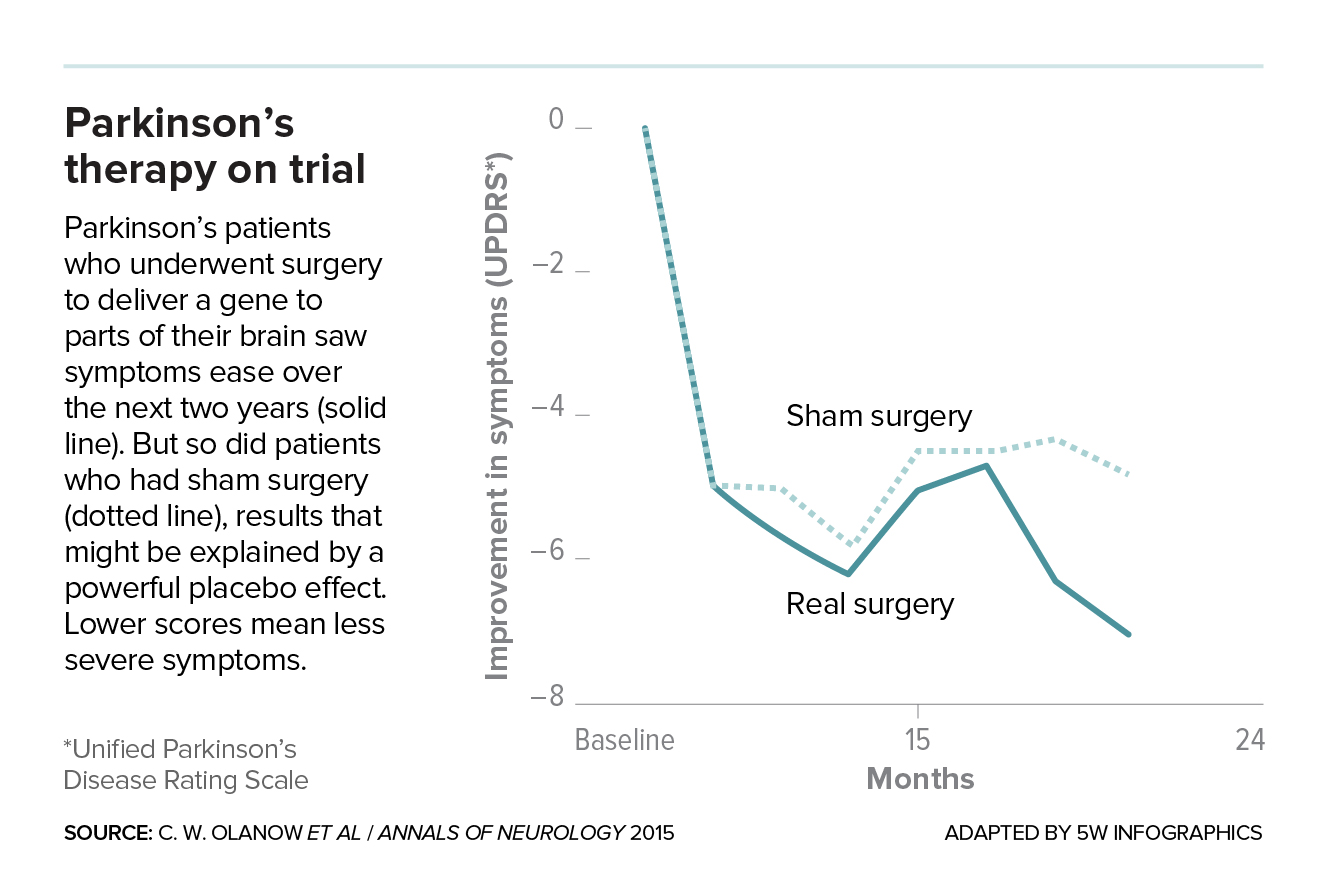
Medically meaningful placebo effects have turned up elsewhere. “The clinical picture that’s emerging is that in many disorders the placebo response is quite strong,” says cognitive neuroscientist Tor Wager of the University of Colorado Boulder. And that response is shaped by a variety of psychological forces.
Pavlov’s placebo
One of these psychological ingredients may be simple conditioning, a study from Napadow’s lab makes clear. After regularly coming into the lab to receive a small injection of an allergen in their skin, participants learned that the skin prick made them itch. But after a while, the researchers switched the allergen for salt water. “They were led to believe that this is the same allergen they’d been feeling all along,” Napadow says.
And lo, they believed it. Participants rated the sensation as itchy, and their brains showed itch-related activity similar to the traditionally acquired itch, Napadow and colleagues reported in Allergy in 2015. “You imagine the itch and you are in fact itching,” he says. “Your perception becomes your reality.”
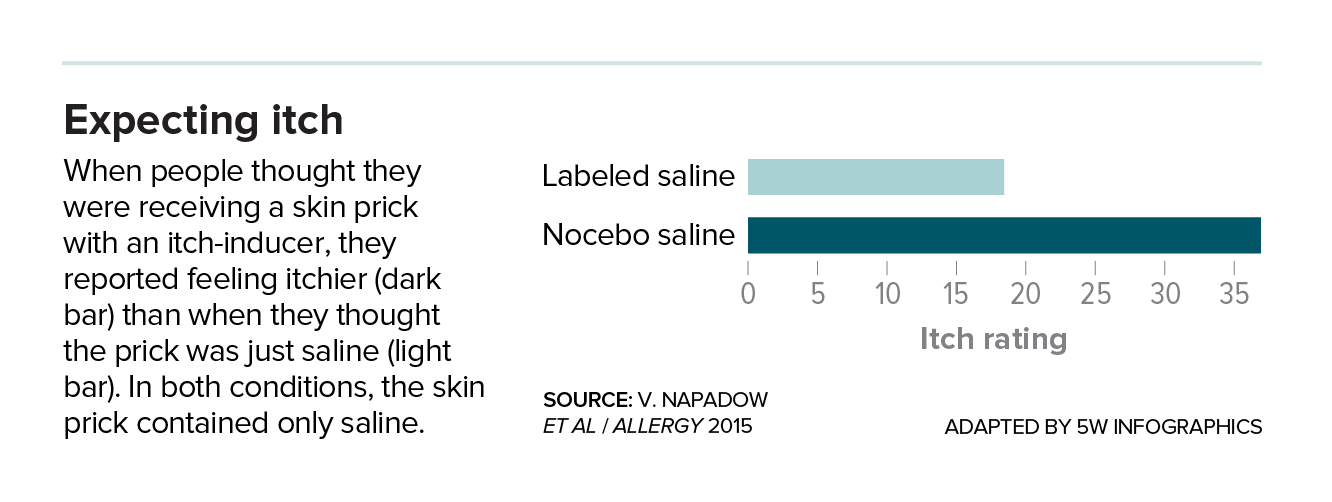
That type of linking of two events may help explain much of the placebo effects that have been observed in creatures with very little psychological baggage: animals and infants, who, it’s been shown, can learn to expect certain outcomes after taking a drug or undergoing a procedure. While this type of Pavlovian learning is certainly part of the placebo spectrum, such conditioning “doesn’t explain the whole story,” says Katja Wiech, a pain researcher at the University of Oxford. That’s true particularly when it comes to pain.
People are very good at remembering something that hurts. After a back injury, a person knows exactly which movements to avoid. But “forgetting pain is so much harder,” Wiech says. At the placebo conference in the Netherlands, she presented data that suggest it takes about three times as much evidence for people to learn that the pain is gone.
“It’s not about the experience. It’s about the sense you make out of your experience.”
KATJA WIECHIf perception were as simple as receiving input from the senses, that difference in learning and unlearning pain might not exist. People would be keen observers of the sensory cues coming in and adjust their experiences to fit with them. But incoming sensory information — a throbbing toe, for instance — is not the only signal that matters. “Over time, we’ve learned that there’s not a direct proportional relationship between tissue damage and the pain,” Wiech says. People can learn to feel pain when they expect it, whether it’s there or not.
The pain signals that zing from the toe to the brain are but one piece of evidence the brain uses to build its narrative. Some information is more powerful than others, and we weigh it accordingly. “It’s not about the experience,” Wiech says. “It’s about the sense you make out of your experience.”
Mapping placebos through the brain
No matter what they are called, some placebo effects take hold of a compelling piece of neural real estate, Wager and colleagues argue: the ventromedial prefrontal-cortex, or vmPFC. This cortical patch lies near the very front of the brain, behind the eyes. From its perch, the vmPFC forms neural connections that enable it to both help form beliefs and execute their orders. Drawing on memories, sensory cues and emotional input, the vmPFC evaluates relationships between things and creates an idea of the self, positioning a person in the context of her world.
Because of its far-flung connections to the spinal cord, skin, heart and immune system, the vmPFC and its vast neural networks may also orchestrate the body’s responses to these beliefs. Scientists are drawing increasingly detailed maps of the roads that lead from beliefs in the brain to changes in the body, progress detailed by Wager and his colleagues in 2017 in the Annual Review of Neuroscience.
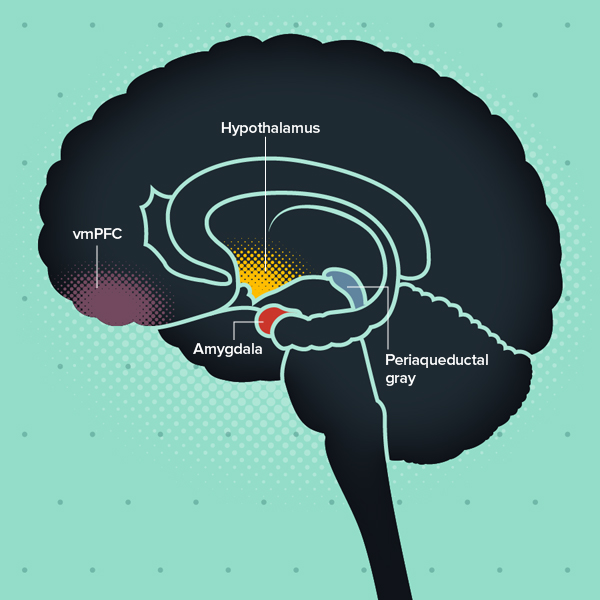
PLACEBO HOTSPOTS Over the last decade, scientists have been tracking placebo effects to specific locales in the brain. Although many different areas appear important in mediating certain effects (including the hypothalamus, the amygdala and the periaqueductal gray), the ventromedial prefrontal cortex (vmPFC) has garnered recent scientific interest.
CREDIT: TEXTBOOK EXAMPLE (CC BY-ND)
Take pain, for example. Scientists have traced a pathway that converts neural activity into perception of a throbbing toe, for instance, and the vmPFC seems to be a key node. Neurons in the vmPFC send signals directly to a part of the spinal cord called the periaqueductal gray, a hotbed of pain-detecting and pain-alleviating neurons. Other signals arrive here from the amygdala, a structure involved in emotions; the nucleus accumbens, linked with motivation and addiction; and the hypothalamus, a brain structure with basic bodily jobs of regulating temperature, hunger and sleep. These brain structures are all in deep communication with the vmPFC.
This admixture of signals, which can dial pain up or down, gets shuffled through several more middlemen before creating the sensation of back pain, for instance. Neuroimaging studies suggest that placebos can tweak signals all up and down this pathway. One of the strongest responders to placebos is the vmPFC, Wager and others have found.
Those rose-colored assessments mean that a person might selectively see what she already believes. A self-fulfilled prophecy is built.
A similar pathway exists for a parallel but distinct part of the nervous system called the autonomic nervous system. This network can soothe the body or turn it into a sweaty, heart-thumping lump of panic. Recent work on Cebus monkeys revealed synaptic fibers that run from a part of the pre-frontal cortex near the vmPFC and other cortical areas to a part of the adrenal gland, which can flood the body with adrenaline. The immune system is within the vmPFC’s reach, too. Activity in the region is thought to spur the body to produce inflammatory cytokines and other immune system signals.
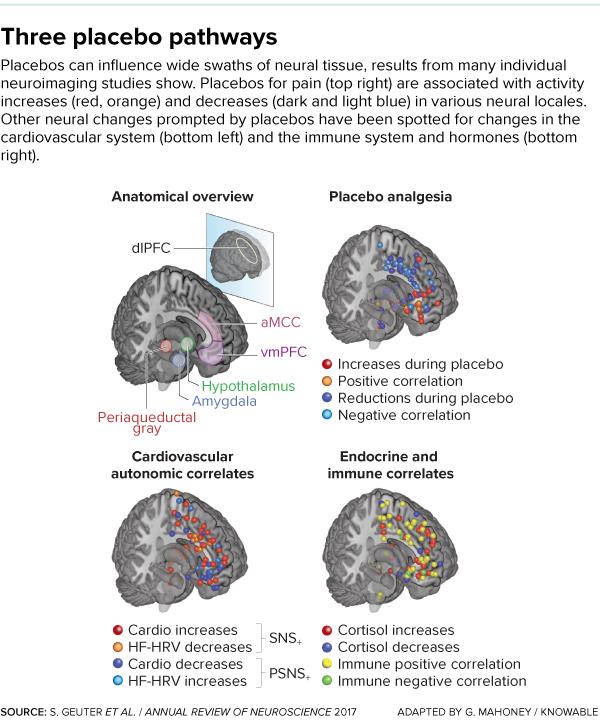
Placebos’ influences on these pathways remain to be worked out, but Wager and others suspect that the vmPFC may turn out to be a key regulator. What’s more, this brain area and its many collaborators may be involved in triggering a positive experience that lasts, Wager believes. His talk at the placebo meeting was about why some placebo effects seem to linger far beyond the time they’d be expected to fade.
Wager’s idea, and one that recent work from his lab backs up, is that placebo effects kick off feedback loops of goodness. “Once you have a positive expectation, you’re biased toward looking for and learning from things that match those expectations,” he says. “You value the good stuff and discount the bad stuff.” Those rose-colored assessments mean that a person might selectively see what she already believes. A self-fulfilled prophecy is built.
Better living through placebos
But despite the positive results, placebos as treatments haven’t overcome their stigma to reach doctors’ offices yet. “We have some pretty good success” with disorders like depression, anxiety and migraines, Kelley says. “But I don’t think anyone is prescribing them. It just feels wrong.”
“Yes, kind of weird, but in a somewhat mysterious way, empowering,” a top reviewer writes [of “honest” placebos on Amazon].
People could seek out a placebo prescription. It turns out that’s not necessary, since commercial, over-the-counter “honest” placebos exist. You can Amazon Prime yourself 45 Zeebo brand pills for $24.90. That may seem like a lot to pay for gelatin capsules clearly labeled as containing “no active ingredient,” but there’s evidence that more expensive placebos work better than cheap ones. “Yes, kind of weird, but in a somewhat mysterious way, empowering,” a top reviewer writes.
More palatable to physicians may be ideas such as, with the patient’s agreement, slowly tapering a patient’s dosage of an opioid painkiller or other drug. That way, a patient might get pain relief without the risk of side effects or addiction.
Still, as the more expansive concepts of mindset and beliefs imply, patients’ outlooks can be tweaked without pills, creams or sham surgery. Doctors can take time to sit down, talk through the rationale of why a certain treatment might work, smile. Some people believe that those actions, called the “common factors” in the therapy world, are responsible for much of the improvements that come with psychotherapy. (The controversial “Dodo Bird Verdict,” proposed in the 1930s by psychologist Saul Rosenzweig, posits that most forms of psychotherapy are equally effective, thanks to these common factors. As the dodo said to Alice and her companions in Wonderland after a circular race with no start and no stop, “Everybody has won, and all must have prizes.”)
Napadow and colleagues are searching for the neurobiological markers of what scientists call the “therapeutic alliance” by measuring brain activity concurrently in doctors and patients. By creating positive expectations, good rapport might lead to better outcomes, the researchers suspect.
But even the low-tech approach of smiling and seeming to care has not yet made it into the clinic in a rigorous way. “The science of motivation, expectation and decision-making hasn’t percolated into medical practice,” Wager says. “And that would be such an exciting thing to see happen. The science we’re doing is preparing the way for that.”
Of course, placebos — or more general psychological adjustments — won’t work for everything, or perhaps even most things. You can’t think your way out of a brain tumor, Napadow says. “There are obviously going to be limits to how much our brains can control the diseases that are ravaging our bodies,” he says.
“I feel pretty good that there are some people doing placebo research who just really want to know the answers,” no matter how the results turn out, Wager says. “And we need that. Desperately.”
One telling example of placebos’ shortcomings appeared in the New England Journal of Medicine in 2011. People with asthma came into a lab at Harvard and were treated with an albuterol inhaler, a placebo inhaler or sham acupuncture. Afterward, the patients reported similar levels of improvement for all three treatments, but their airways felt the difference: Only after getting the active drug could people objectively blow more air out of their lungs. People taking placebos felt better, but they still couldn’t breathe.
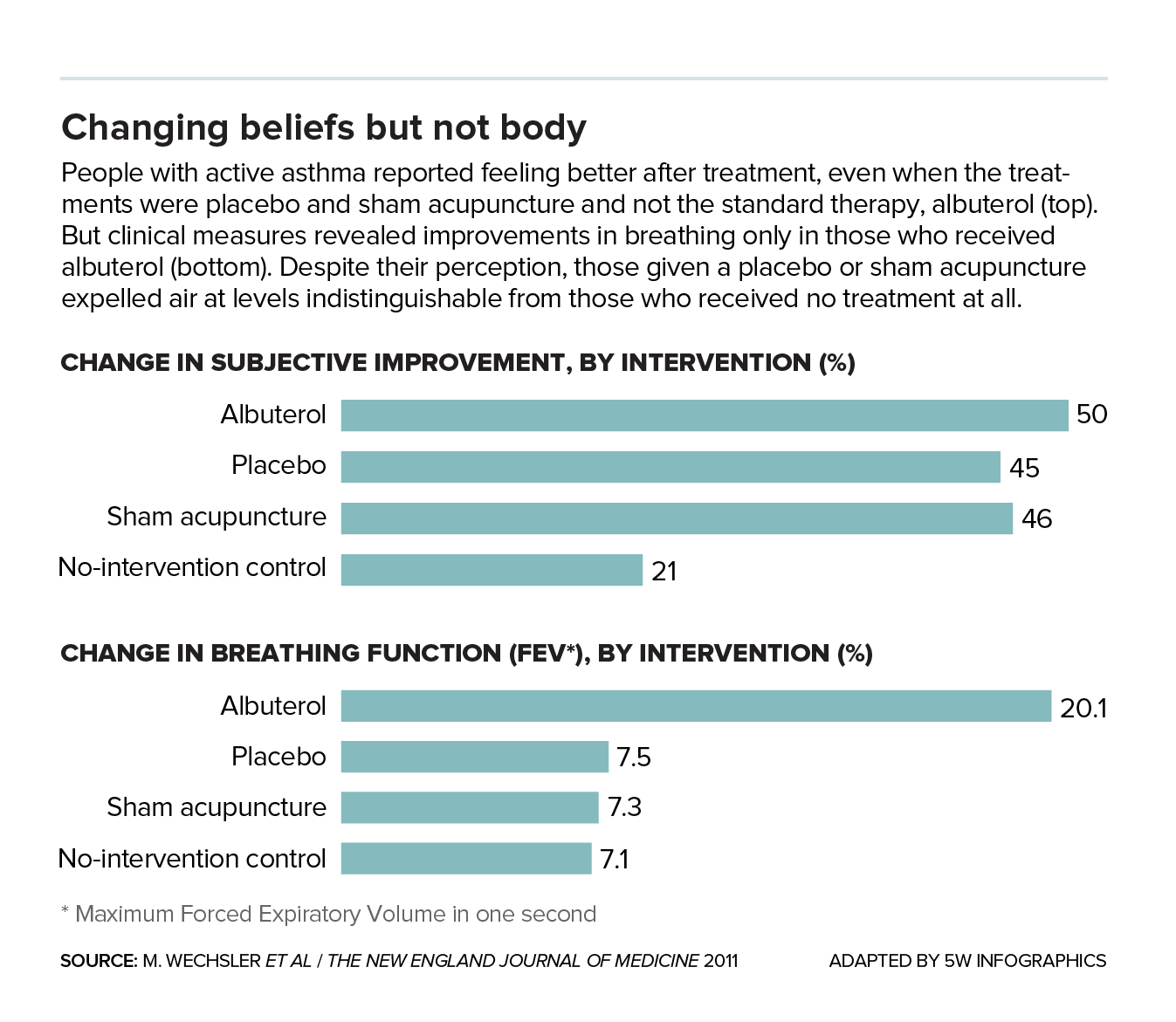
That study illustrates some newfound rigor for the field of placebo research, which has been plagued by a pro-placebo bent in some cases, Wager says. “I feel pretty good that there are some people doing placebo research who just really want to know the answers,” no matter how the results turn out, he says. “And we need that. Desperately.”
For now, the questions still outweigh the answers, a point made by a study Wager and colleagues are conducting now. The researchers combined data from most of the existing brain imaging studies on pain and placebos, about 20 studies in all. Overall, placebos’ effect on the pain network in the brain — the one that supposedly jumps into action when something hurts — seems surprisingly small. “For me, that opens up the door to say, ‘OK, it might be pretty rare for placebo manipulation or treatment to have a deep impact on the things that cause pain,’” Wager says. That said, other brain circuits, such as those that handle motivation and value, might have the power to override this pain signal in the brain to make people feel better, he says.
Untangling the various ingredients that shape our mindsets may well alter clinical practice one day. “There are principles to how we come to those beliefs and how we change them,” Wager says. And now, those principles are beginning to take shape, emerging from their shady history and asking for proper names.




